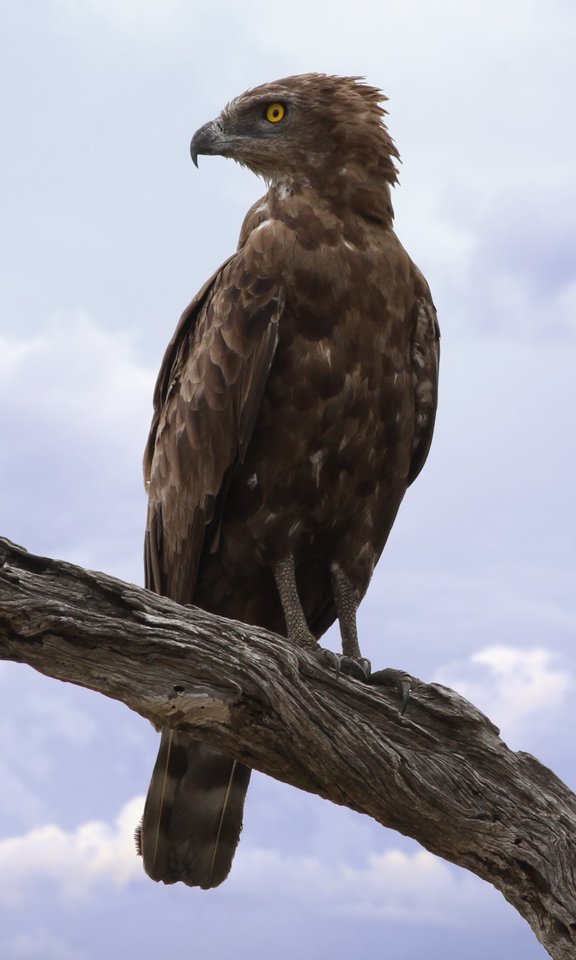Brown snake eagles are known for their diverse diet, which primarily consists of snakes. However, during the winter months, when reptiles are often underground to avoid the cold, these birds of prey may switch to other food sources. Let’s explore what brown snake eagles typically eat in the winter season.
The Varied Diet of Brown Snake Eagles
Brown snake eagles are opportunistic feeders, meaning they will consume a wide range of prey depending on availability. While snakes are their primary food source, these birds have been observed feeding on a variety of other animals, including:
- Mammals (rodents, rabbits, hares, hedgehogs)
- Birds
- Lizards (including chameleons and geckos)
- Amphibians
- Invertebrates (such as millipedes)
Hunting Techniques of Brown Snake Eagles
 Image source: Brown snake eagle By Derek Keats
Image source: Brown snake eagle By Derek Keats
Brown snake eagles employ two main hunting strategies to capture their prey:
- Stooping from a High Perch: The eagles will perch on a high vantage point, such as a tree or cliff, and then swoop down on their unsuspecting prey.
- Hovering in Open Areas: In more open habitats, the eagles will hover in the air, scanning the ground for any movement, before dropping down to seize their target.
Dietary Shifts in Winter
During the winter months, when reptiles are less active and often underground, brown snake eagles may need to adjust their hunting tactics and prey preferences. According to a study by Bakaloudis, Vlachos, and Holloway, non-reptilian prey, such as mammals, birds, and invertebrates, can become more important in the eagles’ diet during this time.
Threats to Brown Snake Eagles
While brown snake eagles are adaptable predators, they face several threats that can impact their populations:
- Habitat Loss: Deforestation and urbanization can reduce the available habitat for these birds, forcing them to search for prey in less suitable areas.
- Shooting and Electrocution: Brown snake eagles can be accidentally shot or electrocuted by power lines, which can be a significant cause of mortality.
- Lead Poisoning: Ingesting lead fragments from the remains of shot animals can lead to lead poisoning in these birds of prey.
Conservation Efforts
To ensure the continued survival of brown snake eagles, conservation efforts are crucial. These efforts may include:
- Protecting and restoring suitable habitats for the eagles
- Implementing measures to reduce the risk of collisions with power lines
- Educating the public about the importance of these birds and the threats they face
- Promoting the use of non-lead ammunition to reduce the risk of lead poisoning
In conclusion, brown snake eagles are adaptable predators that can adjust their diet to suit the availability of prey, even during the winter months. While snakes remain a staple in their diet, these birds will also consume a variety of other animals, including mammals, birds, reptiles, amphibians, and invertebrates. Understanding the dietary habits and threats faced by brown snake eagles is crucial for their conservation and the preservation of healthy ecosystems.
References:
– Bakaloudis, D.E., C.G. Vlachos, and G.J. Holloway. 1998. Habitat use by Short-toed Eagles Circaetus gallicus and their reptilian prey during the breeding season in Dadia Forest (north-eastern Greece). Journal of Applied Ecology 35:821-828.
– Bakaloudis, D.E., C.G. Vlachos, and G.J. Holloway. 2000. Nest features and nest-tree characteristics of Short-toed Eagles (Circaetus gallicus) in the Dadia-Lefkimi-Soufli Forest National Park, northeastern Greece. Journal of Raptor Research 34:293-298.
– The Peregrine Fund. Short-toed Snake-eagle. https://peregrinefund.org/explore-raptors-species/eagles/short-toed-snake-eagle

